Home »

Waxing Crescent Moon marks countdown to Harvest Moon
By Dan Hicks
The Sept. 1 waxing crescent moon marked a cosmic countdown as Luna steadily grows to become our September 13 Harvest Moon (22:33 MDT).
My telephoto image (above) shows the moon in the summer evening twilight, setting in the west over silhouetted Cranbrook treetops as a flock of our ubiquitous crows makes a final flight before dark. The next brightest natural night sky object was Jupiter – the banded planet, prominent to the south with a magnitude of minus 2, situated just above the constellation Scorpius (the scorpion), but within Ophiuchus (the serpent holder).
To the left of Jupiter was Saturn – the ringed planet, dimmer at magnitude zero, in the constellation Sagittarius (the archer), above the constellation’s Teapot asterism. Both Jupiter and Saturn are the gas giants of our solar system, composed primarily of hydrogen, they are the fifth and sixth planets respectively, and the innermost of the four outer planets; both could easily swallow our comparatively minute Earth whole without its ingestion causing them any indigestion whatsoever – Jupiter is 318 Earth masses and Saturn 95.
Astronomically, crows are a somewhat privileged avian species; among the stars, they have their own night sky constellation – Corvus the crow (aka a raven), but this honour is hardly unique.

Of the 88 International Astronomical Union constellations, nine are named after birds; eight of which are real-life birds, and four of which are visible from our latitude here in Cranbrook, or more precisely – from dark sky locations beyond the glare of our city lights. Besides Corvus, the other three birds flying in our dark night skies are Aquila (the eagle), Columba (the dove), and Cygnus (the swan). Those who travel to tropical climes can aspire to behold all nine of these heavenly sky birds, including the mythical Phoenix.
Birds are big with the Rocky Mountain Naturalists, turtles, flowers, and fossils too; and on rare occasions, they have even pondered the stars and planets under a natural night sky.
The preeminent Cranbrook nature society’s first autumnal meeting will be on September 18 at 7 p.m. at the College of Rockies.
A third notable occurrence this month is autumn’s arrival with our autumnal equinox on September 23 (01:50 MDT).








